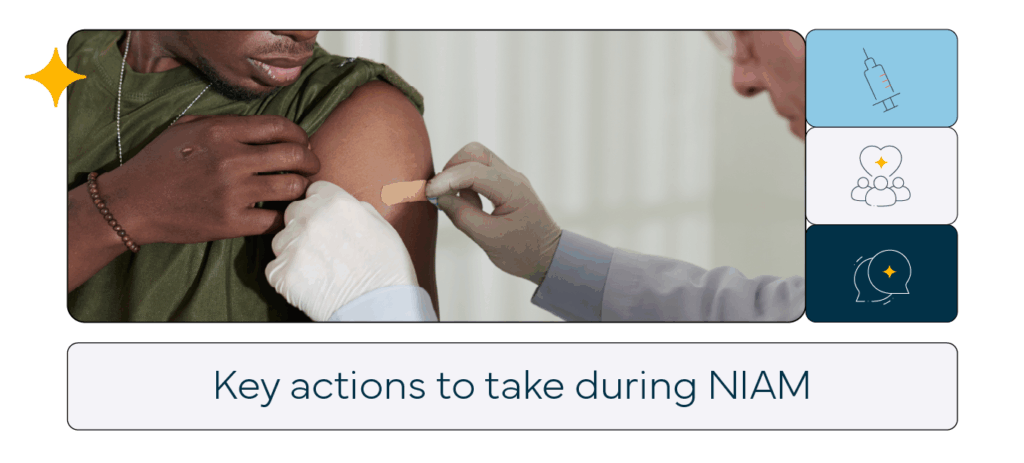Each August, National Immunization Awareness Month (NIAM) offers an important opportunity for colleges and universities to reflect on their role in protecting the health of their students and broader campus communities. Immunizations remain one of the most effective tools we have to prevent illness, reduce the spread of disease, and protect vulnerable populations.
But in today’s polarized climate, misinformation and skepticism about vaccines are more widespread than ever. For young adults who are forming their health behaviors and making independent health decisions for the first time, the campus environment can be both a source of accurate information, or a breeding ground for myths. Health centers alone cannot shoulder the responsibility of promoting immunizations. To succeed, colleges and universities need a campus-wide strategy to strengthen vaccine confidence and ensure equitable access.
Below are key actions that both health centers and the broader university community can take during NIAM—and throughout the year—to advance these goals.

1. Health Centers: Make Vaccination Easy and Accessible
The most direct role of campus health centers is to remove logistical barriers to vaccination. When students can walk in between classes or attend well-publicized vaccine clinics, they are far more likely to follow through. Practical steps include:
- On-site clinics and pop-ups. Offering vaccines at the health center, but also in high-traffic areas like student unions, residence halls, or athletic facilities. Short-term pop-up events can generate visibility and normalize the act of getting vaccinated.
- Extended hours and walk-in availability. Students often have unpredictable schedules, so health centers should consider flexible hours, same-day appointments, and minimal paperwork.
- Partnerships with local providers and pharmacies. Not every vaccine may be available on campus. Formal partnerships with community pharmacies, local health departments, and hospitals ensure that students can be referred quickly and easily. Coordinated communication between institutions helps students navigate access.
- Clear insurance and cost guidance. Uncertainty about coverage is a major deterrent. Health centers should proactively explain which vaccines are covered under student health plans, what low- or no-cost options exist, and how students without insurance can still access care.
2. Faculty and Staff: Reinforce Accurate Information
Students look to their professors, advisors, coaches, and supervisors for cues—not just about academics or athletics, but about life choices. These touchpoints provide opportunities for trusted adults on campus to reinforce accurate, evidence-based information about vaccines. Universities can support this by:
- Providing training and resources. Offer faculty and staff simple talking points, FAQs, and links to reliable sources like the CDC, American College Health Association, and state health departments.
- Encouraging open dialogue. When misinformation arises in class discussions, campus forums, or casual conversation, trusted adults can gently guide students toward accurate information.
- Modeling healthy behavior. Faculty and staff who share their own vaccination experiences—“I just got my flu shot at the campus clinic”—can normalize vaccines as a routine part of health.
3. Student Organizations: Harness Peer Influence
Students are most influenced by their peers. Student organizations, whether fraternities, sororities, athletic teams, cultural clubs, or residence hall councils, play a critical role in shaping attitudes. To mobilize these groups, universities can:
- Support peer ambassador programs. Train and empower student leaders to spread accurate vaccine information through tabling events, social media campaigns, or residence hall meetings.
- Incorporate vaccines into campus traditions. For example, offering a flu shot booth at the fall welcome fair, or including vaccine reminders in student government newsletters.
- Create visible campaigns. Students designing and leading campaigns that highlight “why I vaccinated” stories can be especially persuasive in countering myths.
4. Campus Communications: Counteract Misinformation
In the era of social media, misinformation spreads rapidly and often more loudly than scientific fact. Colleges and universities have the advantage of trusted communication channels that reach nearly every student. Effective strategies include:
- Consistent, multichannel messaging. Share accurate vaccine information via email, campus apps, websites, posters, and digital screens. Reinforce messages repeatedly across platforms.
- Rapid response to myths. If a false narrative begins circulating on campus or online, health centers and communications teams should quickly provide clear, evidence-based corrections.
- Student-centered framing. Messaging should highlight what matters to students—avoiding illness that interrupts classes, protecting teammates or roommates, and contributing to the well-being of the campus community.
5. Leadership: Set the Tone at the Top
Finally, university presidents, deans, and senior leaders have a unique platform to set the tone. When leaders publicly support vaccination, acknowledge the challenge of misinformation, and commit resources to improving access, they send a powerful signal. For example:
- Issuing statements during NIAM that affirm the university’s commitment to public health.
- Participating in campus vaccination campaigns or events.
- Allocating funding for outreach, additional staffing, or expanded clinic capacity.
A Campus-Wide Effort for Long-Term Impact
National Immunization Awareness Month is more than just a reminder to get vaccinated—it’s a call to action for colleges and universities to leverage their full community. Health centers play the frontline role, but faculty, staff, student leaders, communications teams, and senior leadership all have a part to play.
By uniting around accurate information, increasing vaccine access, and normalizing preventive care, campuses can help students develop lifelong habits of health. In an era of growing vaccine hesitancy and politicization, colleges and universities are uniquely positioned to model how communities can come together around science, compassion, and shared responsibility.
This year, let’s use NIAM as a springboard—not just for awareness, but for sustained, campus-wide action that protects students today and prepares them for healthier futures.

References
- Centers for Disease Control and Prevention (CDC). National Immunization Awareness Month (NIAM).https://www.cdc.gov/vaccines/events/niam/index.html
- American College Health Association (ACHA). Vaccine Resources for Colleges & Universities.https://www.acha.org/vaccines
- World Health Organization (WHO). Ten Threats to Global Health in 2019 – Vaccine Hesitancy.https://www.who.int/news-room/spotlight/ten-threats-to-global-health-in-2019
- American College Health Association. Guidance for Immunization and Preventive Services in College Health.Journal of American College Health, 2022.
- Opel, D.J., & Diekema, D.S. (2022). Vaccine Hesitancy: A Review of the Literature. Annual Review of Public Health, 43, 459–477.


